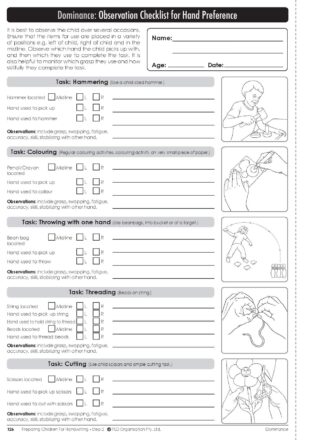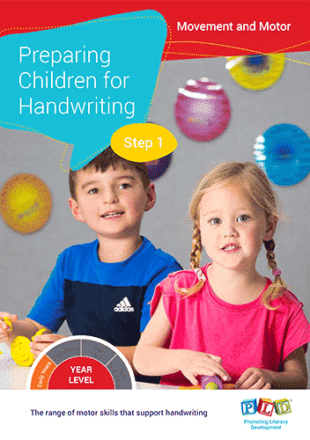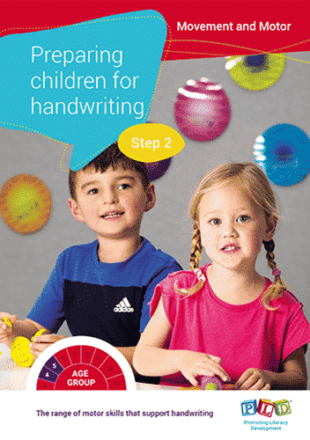It is quite common for children to arrive into Foundation without a dominant hand. As teachers are not Occupational Therapists, how do you help establish a student’s dominant hand as left or right and why is it so valuable to do so? Research suggests that while a majority of children show a preference by 3 years of age, and others by school age, some students actually establish dominance as late as 8 or 9 years old.
Making a preference is important as it allows the child to develop skill and endurance with that hand from an early age. If a child has not yet made a preference by the Foundation Year, PLD suggests that the child is encouraged to participate in activities that involve crossing the midline, and activities using both hands together to establish a student’s dominant hand. Some activities should be designed where both hands are active and others where one hand does the work and the other helps. Don’t try and choose the hand for the child, however, you can observe to see which you think is used most often or is more skillful. Please refer to our downloadable ‘Observation Checklist for Hand Preference’.
What are Midline Crossing Activities?
Midline activities are those where children cross their body with their hand and arm e.g. the left hand moves across the body to the right-hand side, or the right hand moves across the body to the left-hand side. Suggested activities to establish a student’s dominant hand may involve:
- reaching across the body to retrieve an object
- placing, or throwing an object across the body
- moving the hand and arm in patterns that cross the body
The child should be encouraged to complete the activities with both left and right hands.
What are Bilateral Activities?
To successfully have a dominant hand, a child must have some proficient symmetrical bilateral hand skills. Bilateral activities are those that involve both hands together. Initially, you are encouraged to allow the child to use both hands together in a simple movement which requires both hands to perform the same action. Some examples to establish a student’s dominant hand include:
- throwing/bouncing/catching a ball with two hands
- spinning two hoops one on each arm
- using socks with balls in each toe, the child stands with their back to the wall, cross body and bounce the ball on the wall
- drawing circles simultaneously with both hands on board
- making circles with arms while holding streamers
- passing object over and underbody
- swinging and hanging on monkey bars
- rolling out playdough with a rolling pin
- making a playdough snake using two hands
- marching to music
- walking on stilts
- ‘Simon says’ with movements that involve crossing the body
- Drawing around stencils or drawing around hands
- playing Twister (™)
- forward rolls and holding ball in feet
Graduate to using hands in co-operation where hands are doing different movements. When the child has lots of time using one hand to do the work and the other to do the holding, they will decide eventually which is the best hand to use.
- Cutting
- Colouring
- Cooking mixing and cutting
- Threading
- Hammering
- Nuts and bolts
- Bat and ball
What if it’s still not clear which is the student’s dominant hand?
We would recommend working through our ‘Observation Checklist for Hand Preference’ to establish the student’s dominant hand. Here are some guidelines for using the checklist:
- As a general rule, it is always best to observe the child on several occasions.
- You need to ensure that the items are placed in a variety of positions e.g. left of child, right of child and in the midline.
- Observe which hand the child picks up the item with, and then which hand they use to complete the task.
- It is also helpful to monitor which grasp they use and how skillfully they complete a selection of the following suggested tasks.
Once you have completed the above, if you are still unable to establish a student’s dominant hand, then it may be useful to refer the child to an Occupational Therapist for further assessment, prior to the commencement of Year 1. The above checklist is an extract from the pld resources Preparing Children for Handwriting – Step 2. Learn more about this essential PLD resource in our Foundation Movement & Motor Starter Pack.
Additional Movement & Motor milestones
PLD has produced a range of more Movement & Motor milestones for Early Years and Foundation students, click on the links below to download the milestones fact sheets to assist with establishing the student’s dominant hand.
- Developing Cutting Skills Milestones – Ages 3-6
- Fine and Gross Motor Development – Ages 4 & 5
- Getting Reading for Writing (Pre-Writing Patterns) Factsheet
- Pencil Grip and Drawing Skills – Ages 1-6
-
Preparing Children for Handwriting – Step 1$82.50$82.50 incl. GST
-
Preparing Children for Handwriting – Step 2$82.50$82.50 incl. GST
PLD Underpins High Performance
The 2015 Department of Education Western Australia study, conducted by Professor William Louden, selected nine top-performing schools based on their NAPLAN results and reviewed their processes. The report, “High Performing Primary Schools: What do they have in common?” noted key characteristics included lower variation in teaching methods and the use of explicit teaching strategies for teaching phonological awareness and phonics.
Among the mandated resources utilised within these schools were synthetic phonics resources. PLD’s programs were commonly used in the schools investigated. Professor Louden found that high-performing schools used explicit teaching strategies for teaching phonological awareness and phonics through a Structured Synthetic Phonics (SSP) program.



 print
print

